September 2010 Arctic Ice Extent Handicapping Via ARCUS
Posted on 24 June 2010 by Doug Bostrom
Guest post by Doug Bostrom
Unusually low ice cover in 2007 galvanized public attention on Arctic sea ice extent and ever since, discussion at climate-related web sites has raged back and forth on what portends for future Arctic ice behavior. While the trend of sea ice extent seems clear and meanwhile attention has swerved increasingly to ice volume as a better diagnostic of Arctic ice status, all the same everybody's fascinated with weather and what's going to happen next and this year's ice behavior is no exception. The SEARCH division of the Arctic Research Consortium of the U.S. (ARCUS) has gathered and released an informal set of prognostications on the fast-approaching Arctic sea ice minimum for this year.
In all, SEARCH mustered 16 opinions and predictions about this upcoming September's results, spanning the gamut of authors from interested laypersons to the highly expert. SEARCH summarizes:
”The June Outlook for arctic sea ice in September 2010 shows reasonable arguments for either a modest increase or decrease in September 2010 sea ice extent compared to the last two years (5.4 million square kilometers in 2009 and 4.7 million square kilometers in 2008). However, it is important to note that the June 2010 Outlook indicates a continuation of the overall trend in long-term loss of summer arctic sea ice, with no indication that a return to historical levels of the 1980s/1990s will occur.
Reasoning for an increase in sea ice extent from recent years assumes that the current presence of extensive second- and third-year sea ice that we saw in winter 2009/2010 indicates a build-up of multi-year sea ice and a more stable ice pack. Reasoning for a decrease in sea ice extent from recent years, perhaps approaching new record-low minimum, focuses on the below-normal sea ice thickness overall, the thinning of sea ice in coastal seas, rotting of old multi-year sea ice, warm temperatures in April and May 2010, and the rapid loss of sea ice area seen during May.”
Presented graphically, the distribution of predictions:
Quite a reasonable clustering on the whole, although on the left side you can see a lonely outlier. SEARCH welcomes unsolicited submissions to this report if they meet certain easily satisfied requirements, a nice gesture of inclusiveness. That dramatically low estimate is from such a participant, a prediction we hopefully and most likely won't see verified come September.
The other prediction of particular interest for us typically average folks is that of the “Polar Science Weekend “ sponsored by the University of Washington and Seattle's Pacific Science Center. Members of the lay public visiting an exhibit on the polar regions back in February were invited to make predictions after learning some basics of Arctic sea ice and participating in a discussion. PSW describes the results:
We had a total of N = 60 guesses from about six hours of discussions. The mean was 5.1 million square kilometers and the standard deviation was 2.15 million sq km. The mean is quite near that predicted by the trend line (5.15 +/- 0.57 million sq km), but the spread is greater.
Good job, Public!
Full details on the philosophies and methods behind all the predictions as well as affiliations of contributors may be found here (pdf).































 Arguments
Arguments
























 0
0  0
0

 I see from Doug's article Zhang is on the low side for 2010 again.
I see from Doug's article Zhang is on the low side for 2010 again.
 Current extent of ice thicker than 2 m in arctic basin is almost twice as much as it used to be last year, same date. Beaufort Gyre is working hard this year, ice thickness at its center is getting close to 4 m (due to ridging).
Current extent of ice thicker than 2 m in arctic basin is almost twice as much as it used to be last year, same date. Beaufort Gyre is working hard this year, ice thickness at its center is getting close to 4 m (due to ridging).


























Comments